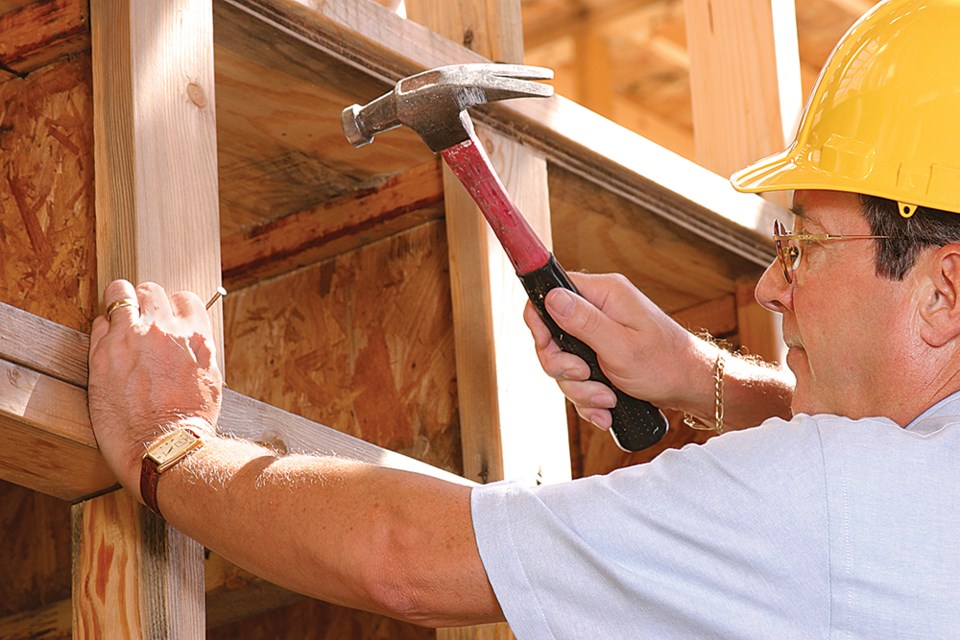The banging of hammers, rumbling of trucks and the chatter of construction workers have become the soundtrack of many Squamish residents’ lives. Whether at home or at work in the district, buildings are going up.
From January to May 31, 99 building permits were issued for Squamish.
These permits total $45 million in construction within Squamish, according to District figures.
Negar Elmieh lives in Dentville and has been surrounded by construction for two years. She sees the positives of all the building.
“It is good for the economy, there’s benefits from population growth – taxes from businesses,” she said.
Elmieh added in the seven years she has lived in Dentville, she has seen neighbours band together and become more of a community. The new homes will also bring lots of great people and more diverse businesses to Squamish, she said.
On the other hand, the rapid pace of construction can negatively affect neighbours.
“There’s no peace anymore,” she acknowledged.
The Chief put out a call on social media for comments on the impact of building in the district and received more than a dozen replies. Complaints varied from constant noise to the work running seven days a week to parking issues and dust.
Andrea Yeung-Meadows, who lives in the Northyards, said the inside and outside of her house is covered in dust from the demolition of two houses next to her.
Nicole Porter lives in the Eaglewind neighbourhood, which has seen considerable construction over the past two years.
“Constant road closures, blocking roads with heavy machinery,” she said.
“They work seven days a week and they usually start before and finish after the noise bylaw hours.”
The current District noise bylaw is being changed to further limit construction noise. The proposed bylaw restricts construction from 7 a.m. to 8 p.m. on weekdays and from 8 a.m. on Saturday.
On Sunday, construction will be restricted to between 10 a.m. and 4 p.m.
Jonas Velaniskis, director of community planning at the District, said staff and council are empathetic to the impact of construction on residents. The District’s about-to-be-published Good Neighbour District guidelines “outline how all residents can consider the impact to others through their actions, and appeals to everyone to take responsibility,” he said in an email. “This is especially important for building sites and all those who work on them – from parking considerations, to waste collection and disposal, to dust abatement, and noise, amongst other things.”
Complaints about construction sites are dealt with on a variety of levels at the District. Bylaw enforcement, engineering and building staff share enforcement duties, depending on the complaint, he said.
“In many cases, District engineering staff or building inspectors are on site and addressing issues proactively directly with contractors. It isn’t easy, therefore, to quantify the number of complaints received within the past year.”
Coun. Ted Prior, who is also a general contractor, said many of the issues residents ace can be mitigated with a simple chat with neighbours before a project begins.
“Be friends with your neighbour,” he said, adding knocking on the doors of nearby houses, explaining what is going to happen and opening up a dialogue for any future issues usually makes the build go smoother.
Prior also explained that construction trades “make hay while the sun shines,” meaning that if the weather is good, the builders need to take advantage of it to get the project completed on time and on budget.
“If you are building a house and it is going to rain on Tuesday and you don’t have the roof on, you’re working Sunday,” he said.
He acknowledged the pace of change in Squamish has made him slightly anxious at times, but ultimately it beats the alternative, he said, noting jobs and the boost to the economy.
“I know most of my construction friends are flat out right now,” he said. “And that is a good thing.”
Dentville’s Elmieh said she totally agrees development is better than a stagnant community, but also questions why so many developments are allowed to rezone or have variances to their permits.
“Those variances have changed the community. I am not opposed to development, but I am opposed to development that contradicts the District’s own OCP.
“The OCP is the vision of what you want the neighbourhood to be,” she said, adding developments around her home have all been allowed variances either to parking, height or setbacks.
Mayor Patricia Heintzman said that rezoning and variances are part of municipal governance and sometimes necessary.
“Every lot is different, every development is different,” she said. There’s generic cookie-cutter guidelines, but they need to be adjusted depending on the situation.
She disagreed that variances cause most of the impact on neighbours.
“I don’t think you can make that patent statement that because a variance is given it therefore has an impact on neighbours.”
Most variances are fairly minor, she said, sighting a slight height variance that may be needed to accommodate an air conditioning unit as an example.




